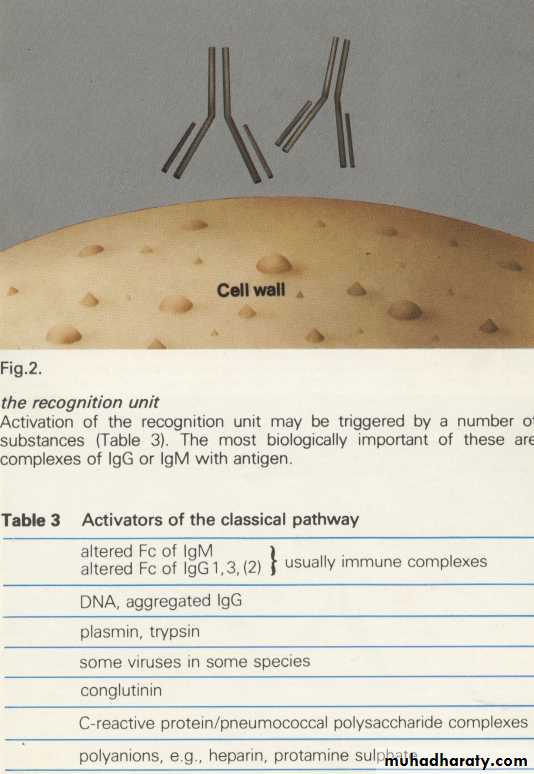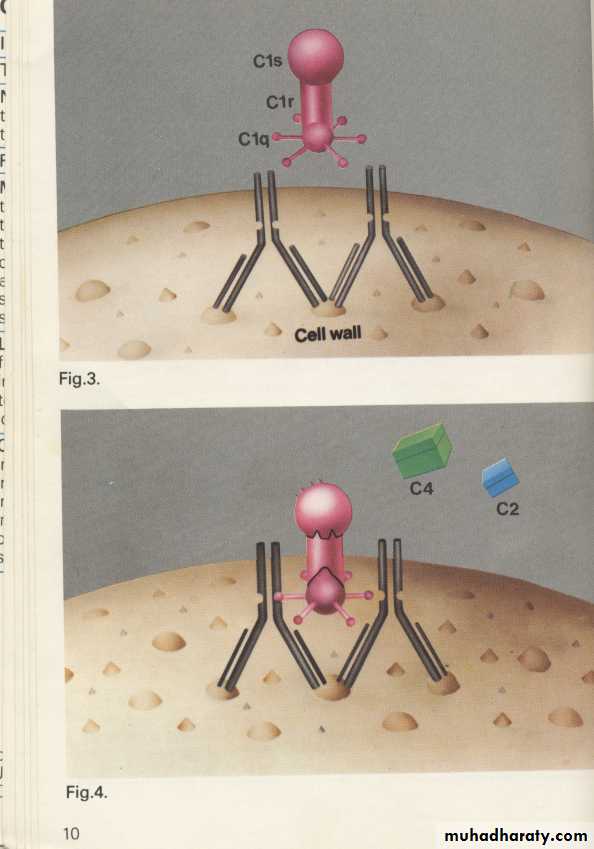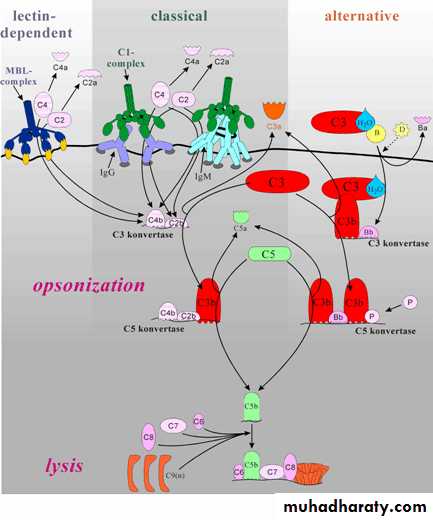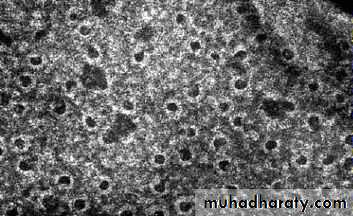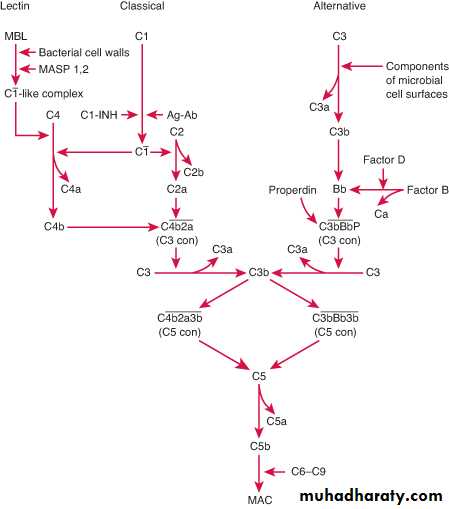Complement system
DefinitionIt refers to a series of 34 proteins circulating in the blood in an inactive form.
They can interact in cascade that leads to a variety of biologic processes.
Complement proteins make up about 10% of serum protein.
Complement pathways
The classical pathwayThe alternative pathway
The Mannan Binding Lectin pathway (MBL)
Nomenclature
1. Classical pathway proteins are labeled with a C and a number ( e.g.: C1, C3). They are named in the order of their discovery (i.e.: C1, C4, C2, C3).2.The alternative pathway components are lettered (e.g.: B, D, P).
3.The mannan binding lectin ,this is a recently discovered system in which lectin binds to mannose residue of the glycoprotein or polysaccharides present in bacterial cell wall or viral envelop. This system starts from C2 and continues up to C9.
Activation of complement pathways
1. The classical complement pathway is activated by
a. antigen-antibody complexes.
b. C- reactive protein
c. cell and plasma derived enzymes such as plasmin and kallikrien.
2. The alternative complement pathway is activated by
a. endotoxin ( bacterial LPS).
b. Cobra venom factor.
c. cell and plasma derived enzymes.
3. The lectin pathway is activated by the interaction of microbial carbohydrates with mannose-binding lectin (MBL) in the plasma and tissue fluids.
The components of the classical pathway
C1 complex (C1q,C1r,C1s)C1 exists in serum as a molecular complex containing:
6 molecules of C1q
2 molecules of C1r
2 molecules of C1s
After the binding of antibody to the antigen, the C1q binds to the constant region of the Ab( CH2 of IgM and IgG).
A single molecule of IgM is enough to initiate the pathway. IgG is far less efficient requiring many molecules to do so.).
Binding of C1q activates C1r and C1s
Activation of classical pathway
Activated C1s (a serine protease) cleaves two serum proteins:
C4 is cleaved into
C4b, which is an active large fragment
and a smaller, inactive, fragment of C4a
C2 is cleaved into
C2b, which binds to a site on C4b
and smaller, inactive, fragment of C2a
The complex of C4b•2b is called "C3 convertase" because it catalyzes the cleavage of C3.
Activation of C3
Activation of C3:C3 is the most abundant protein of the complement system (~1.3 mg/ml).
C4b•2b cuts C3 into two major fragments:
C3b, which binds to the C3 convertase and the target cell making a complex C4b.2bC3b(C5 convertase). Macrophages and neutrophils have receptors for C3b and can bind the C3b-coated cell or particle preparatory to phagocytosis. This effect qualifies C3b as an opsonin.
Formation of membrane attack complex (MAC):
Cleavage of C5 by the C5 convertase initiates the assembly of a set of complement proteins that make up the membrane attack complex.
C5 will be cleaved into C5a and a large fragment C5b.
C5b attaches to the cell membrane away from the C5 convertase complex.
Then C5b binding to the cell membrane will serve as the anchor for the assembly of a single molecule each of C6, C7, and C8.
Cont,
The resulting complex C5b•6•7•8 guides the polymerization of as many as 18 molecules of C9 into a tube inserted into the lipid bilayer of the plasma membrane.This tube forms holes allowing the passage of ions and small molecules.
Water enters the cell by osmosis and the cell lyses.
Activation of classical pathway
The alternative complement pathway
The complement system can be triggered without antigen-antibody complexes.This system is continuously being activated in response to low-grade antigenic invasion and there is a spontaneous conversion of C3 to C3b.
So the activation occurs according to the following steps:
C3b binds a protein called Factor B forming a complex of C3b•B
Once factor B associates with C3b, factor B itself changes conformation and can then be cleaved by the active serum protease factor D, generating Ba and Bb.
Bb will remain associated with C3b to form C3bBb.
2. C3b.Bb is unstable and may dissociate into C3b and Bb. It is stabilized by binding to properdin forming C3b.PBb which is a C3 convertase of the alternative pathway acting on more C3 to form C3a and C3b which may return back to bind with factor B.
3.After accumulations of C3b molecules, C3b•Bb•C3b is formed which is a C5 convertase acting on C5 and can start the assembly of the membrane attack complex as in the classical pathway.
The Mannose Binding Lectin pathway (MBL)
It depends on binding of lectin, it has similar structure to C1q. is a six-headed moleculeIt binds mannose residue of glycoprotein or LPS of bacterial cell wall or viral envelop.
The MB-lectin pathway initiates complement activation in the same way as the classical pathway, forming a C3 convertase from C2b bound to C4b.
Thus in this pathway, activation of C2 and C4 and the late components occurs without C1 activation step.
Functions of the complement system
1.C3a, C4a, and C5a are called anaphylatoxins, they have many physiological effects at the inflammatory siteincreased vascular permeability
smooth muscle contraction.
stimulate mast cell to release histamine.
Causes aggregation of platelets and the release of histamin
2.C5a has chemotactic action, it stimulate movement of neutrophils, macrophages, esinophils and basophils towards site of antigen deposition.
3. Cytolysis, insertion of the C5bC6789 complex into the cell surface leads to killing or lysis of many types of cells including bacteria and tumor cells.
Functions of the complement system
4.Opsonization
Phagocytic cells have receptors for C3b and C4b component, therefore opsonization and subsequent phagocytosis are much enhanced by the activated complement.
Con,
5. Immune complex clearanceImmune complexes with C3b on their surfaces(Ag+Ab+C3b) bound to CR1 on the RBCs.
These complexes are carried through the circulation to the liver and spleen where phagocytic cells eliminate these complexes.
Complement system inhibitors
C1 activity is limited by C1 esterase inhibitor (C1INH). It forms complex with C1r and C1s which are rapidly cleared from the circulation by the REC.Deficiency of this enzyme produces hereditary angioneurotic edema characterized by abdominal pain, skin swelling and bronchospasm which could be fatal.
C4b-binding protein (C4bp)
It first bind to C4b2b resulting in the formation of iC4b and then C4c and C4d which cannot bind to another C2 molecule.
Factor H & I
Factor H binds to C3b and displaces Bb.Factor I cleaves C3b into iC3b, C3c, C3d, these fragments are unable to participate in the lytic pathway and the C3b activities will be disabled.
Complement deficiencies
C2 & C4 deficiency, cause a disease similar to SLE in 50% of pts, due to failure or immune complex clearance.
C3 deficiency is associated with frequent serious pyogenic infection.
Deficiency in factors B, D, P result in increased susceptibility to pyogenic infection.
Deficiency in terminal components, C5,C6,C7,C8 & C9 . Such pts are susceptible to disseminated bacterial infection

